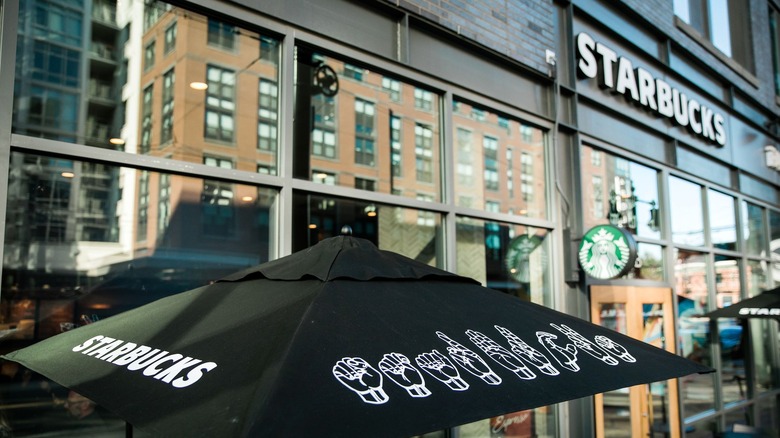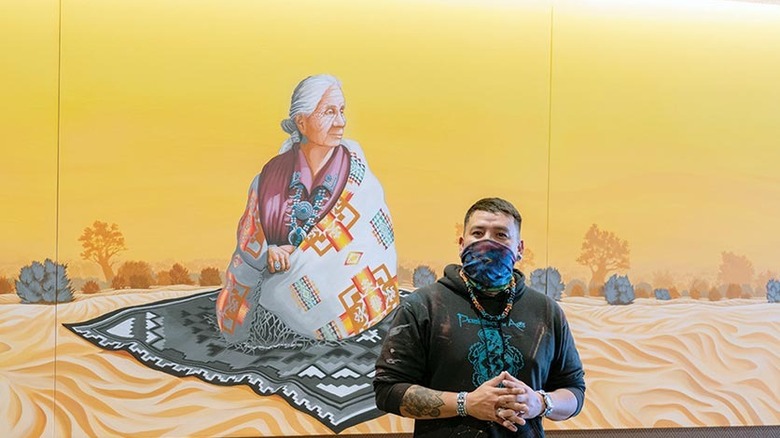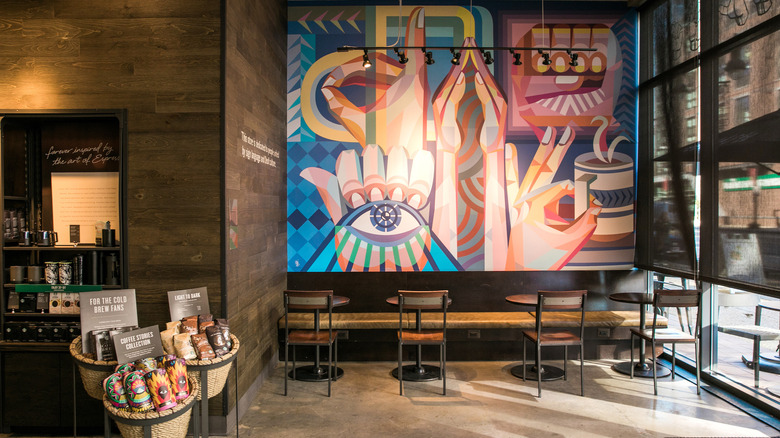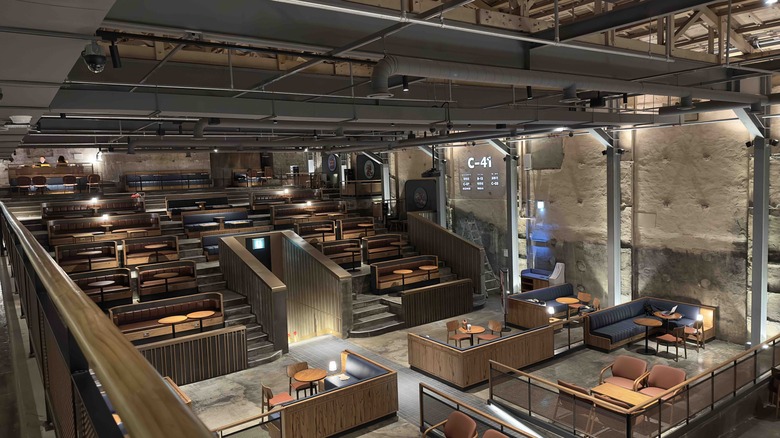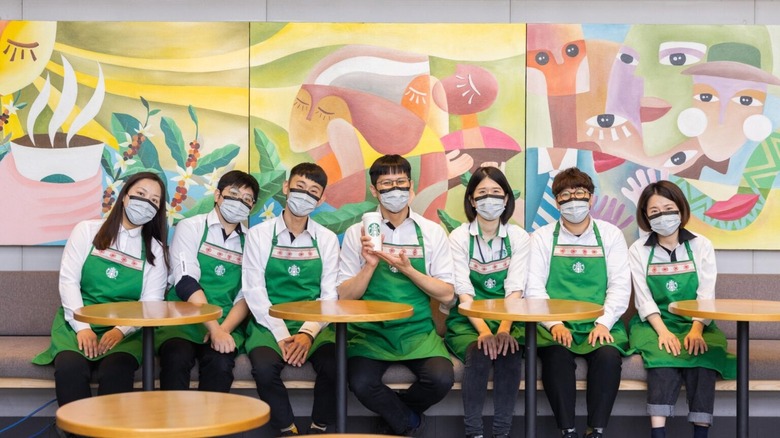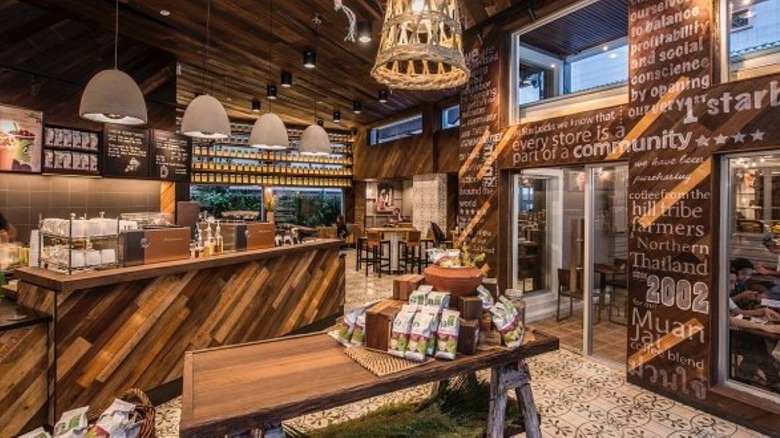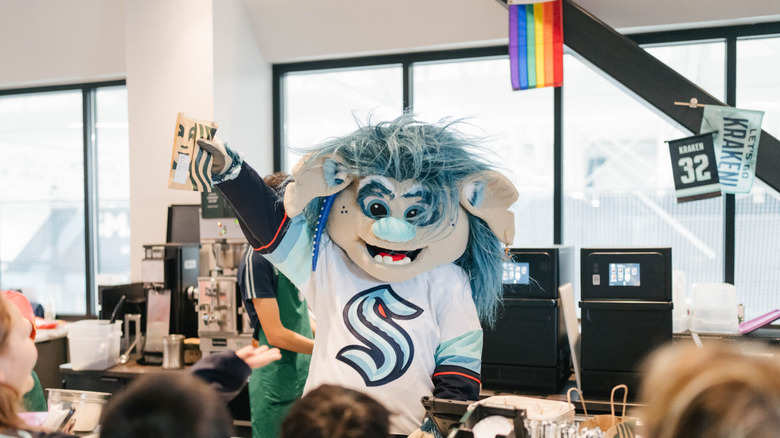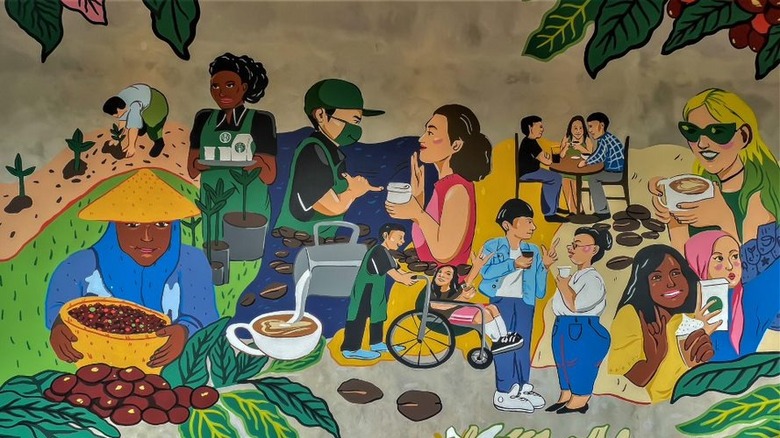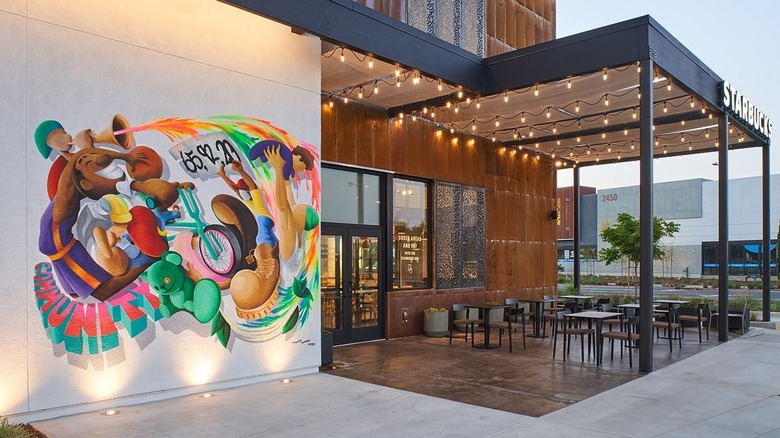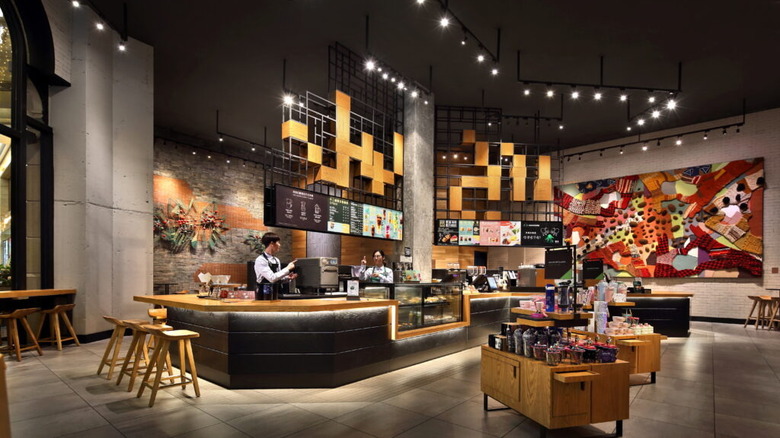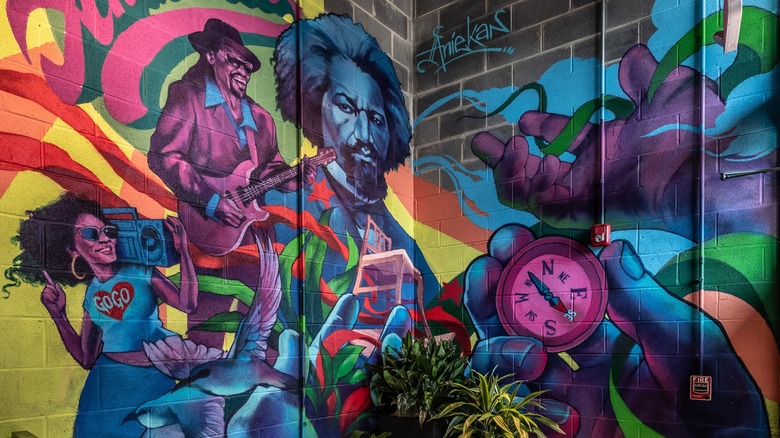What Makes These 11 Starbucks Community Stores Unique
When Starbucks opened its first storefront in Seattle's historic Pike Place Market decades ago in 1971, nobody could have imagined that the brand would soon become internationally synonymous with specialty roasted coffee. What was once a modest, independent coffee shop has now spread across North America and Asia. Consumers reacted with a fever, and growth was inevitable; in 2022, Starbucks boasts more than 34,000 locations globally (via Insider).
According to HomeGrounds, Starbucks is the largest coffee chain in the world as measured by revenue, and as one of our favorite comic book characters says: "With great power comes great responsibility." Aside from the ambitious goal of cutting its environmental footprint in half by 2030, per Starbucks, the company also claims to be "People Positive," signifying that it commits to spreading opportunity, inclusion, and accessibility.
Foremost in the company's plans for expanding inclusivity are its community stores. What makes the Starbucks community stores so unique compared to traditional Starbucks establishments? As the name suggests, each community store serves a specific community; hard of hearing and deaf individuals, indigenous people, local farmers, underrepresented youth, and veterans, to name but a few. While currently, around 150 community stores are operational globally, Restaurant Business Online conveys that Starbucks plans to open 1000 community stores by 2030. Want to add to your bucket list of unique Starbucks locations? Read on and help us uncover some of the most noteworthy community stores you can visit worldwide.
Navajo Nation Community Store: Gallup in New Mexico, U.S.
On the historic Route 66, a small city in New Mexico called Gallup sits just outside Navajo Nation, the largest Native American reservation in the U.S. (via Native Partnership). Gallup, home to over 20,000 residents, has a long history as a commercial center for Indigenous people due to its proximity to Window Rock, the capital and governmental seat for Navajo Nation. Also home to the first Starbucks community store in New Mexico, the store underwent remodeling in 2021 to focus on Navajo Nation and its people.
Uniquely, the store is run almost entirely by Navajo partners and features a dedication next to the front door written in English and Navajo. The inclusion of Navajo is particularly consequential as the language (also known as Diné bizaad) was historically discouraged from use; now, even with over 170,000 fluent speakers, it's considered "at risk." According to Navajo Times, worryingly, fluency among the Navajo has dropped from 93% to 51% from 1980 to 2010. Starbucks hopes the inclusion of the Navajo language in its Gallup store may help revitalize interest in the language for the younger generation.
Inside, "Grandmother with Direction," a 20-foot long mural created by Lók'aa' Dine'é artist Daniel Josley, is a touching homage to Diné elders, for whom the store also serves as a community meeting place. Interviewed by the Navajo Times, Josley says, "I went with the idea of having my grandmother sitting on a Navajo rug, with a traditional Pendleton blanket."
Signing Store: Washington D.C., U.S.
Did you know that ASL (American Sign Language) is, as opposed to being a direct translation of English, a disparate language with unique grammatical rules? According to Lifeprint, we can attribute the development of ASL to Thomas Gallaudet and Laurent Clerc, founders of the first school for the Deaf in America. Half a century later, Thomas Gallaudet's son, amongst others, established Gallaudet University in Washington, D.C. It remains the only school in the U.S. to offer higher education specifically for deaf and hard-of-hearing pupils, with classes taught in ASL and English. Fittingly, you'll find the very first Starbucks signing store nearby.
What does a "signing store" mean? Firstly, every partner at the store (whether deaf, hearing or hard of hearing) is fluent in ASL. Deaf partners wear a striking green apron embroidered with the finger-spelling of Starbucks in ASL while hearing allies have a small "I sign" pin. As not everyone considers ASL part of the deaf experience, per KBIA, or hasn't acquired fluency yet, Starbucks also offers high-tech digital notepads and consoles. There's room to learn, too; the store has a "sign of the week" initiative that illustrates ASL signs for words like vanilla, sweet, and of course, coffee.
The store design is influenced by Gallaudet University's DeafSpace project, utilizing low-glare surfaces. Starbucks collaborated with deaf artists and architects extensively; a mural by deaf artist Yiqiao Wang shows the sign for "community" alongside special mugs designed by deaf artist Jena Floyd.
Community Store: Seoul in South Korea
In northeastern Seoul lies the Kyungdong Market. Inconspicuous from the exterior, hidden within is one of the largest herbal medicine markets in South Korea. According to Time Out, over 70% of the traditional medicines sold in Korea are from Kyungdong (or Gyeongdong) Market. To say the market is mammoth is an underestimation; there are 1000 stalls across several floors, including an old and new market, where consumers can find wholesale and retail fresh vegetables, fish, and handicrafts. Surprisingly, you can also find a heritage theater inside the market, dating from 1962 (via Korea Herald). The theater had a 30-year run before being closed in 1994. Almost 30 years later, Starbucks unveiled a new store inside the theater, which has been affectionately dubbed "Kyungdong 1960." It's the fifth community store the brand has opened in Korea and perhaps the most uniquely located.
The store, which has retained the retro design of the original theater — including 143 seats, each facing the bar — is set to have regular musical and cultural performances by local artists, as per Insider Retail. Order numbers and names projected onto the walls mimic the credit roll of old movies.
Furthermore, it's hoped that the hip atmosphere of Kyungdong 1960 will attract a young customer base who will rediscover and connect with their local community and culture. Starbucks has pledged to donate 300 Korean won (approximately 25 cents USD) from every item sold for the upkeep of the historic Kyungdong Market.
Indigenous Community Store: Hualien, Taiwan
Although Starbucks Stories Asia claims to have opened 540 stores across Taiwan, 2023 was a monumental year for the country, as the first community store in Xiulin Township, Hualien County, opened. The area is well known for its mountainous landscape that is home to the indigenous Truku population.
The Starbucks community store honors the indigenous culture of the Truku people in numerous ways, including in the recognizable Starbucks apron. Alongside tribal women, Truku master weaver Shi Ma Hsiu-Hua designed a totem pattern strip for the aprons that symbolizes the pride and heritage of the Truku people. According to the Council of Indigenous Peoples, weaving, called tminun in the Truku language, is a vital skill passed down through the generations. For many Truku women, mastering weaving represents maturity and adulthood. Additionally, textile art created by Eleng Luluan, a teacher from the Drekay Kucapungane community, hangs on the walls. It depicts coffee trees, as do the vibrant illustrations of Miru Hayung from the Atayal Zihing community.
The store is what Starbucks refers to as a "third place." That's a community space away from home and work, which are known as "first" and "second" places, respectively, that helps to build a sense of connectivity (via Brookings). Starbucks donates a portion of the profits from the store to the Hualien County Private Heping Sustainable Charity Foundation, a movement deeply rooted in the indigenous community and environment. This gesture compliments Starbucks Taiwan's "Indigenous Hope" campaign, which, since 1999, has provided 46,000 indigenous children scholarships.
Farming Communities Store: Bangkok in Thailand
In 2013, Lang Suan Road, Bangkok, became home to the first Starbucks community store to open outside the U.S. and the fourth in operation worldwide. The store is warm and comforting, mirroring a traditional Thai home, with references to farming communities throughout the design.
When interviewed by Coconuts, Starbucks' longest-serving CEO, Howard Schultz, stated he chose to open a community store in Bangkok to showcase the company's commitment to sustaining and supporting local coffee farming communities in northern Thailand. Coffee is big business in the country; the forested mountains and high altitude of north Thailand are ideal for growing arabica beans, the most prized variety for specialty coffee. Indeed, Starbucks only uses 100% arabica beans for their brews (via Starbucks at Home).
Life as a coffee farmer in rural Thailand is challenging. Access to education and health care is subpar, and poverty is rife; that's why Starbucks has set aside 10 baht (approximately 31 U.S. cents) per cup of coffee sold at the community store to help the farming communities. After just one year of operation, Starbucks donated a whopping 1.5 million baht (almost $50,000) to the Integrated Tribal Development Program (ITDP), and later, on the third anniversary, an additional 4.5 million baht (approximately $127,000). Furthermore, for the past 18 years, 5 percent of profits from the sale of Starbucks' locally produced Muan Jai blend has been invested directly into the community, according to Starbucks Stories.
Community Store: Seattle in Washington, U.S.
Ice hockey and Starbucks may seem like an unlikely partnership. Be that as it may, Seattle's local ice hockey team, the Seattle Kraken, recently announced it would become Starbucks' "Community Impact Partner," pledging to improve equality and inclusion across the city (per the NHL). The partnership commenced when Starbucks opened a community store within the Kraken Community Iceplex in Northgate, a historically diverse area.
The Starbucks community store donates a portion of its profits to the One Roof Foundation, an initiative conceptualized by Seattle Kraken and the Climate Pledge Arena, hoping to address and rectify barriers faced by low-income families and BIPOC in sports. They also support local organizations such as Washington Wild and Black Girl Hockey Club, which aim to promote women's ice hockey. There's no denying that staying active, building a community, and developing competitive career skills are beneficial, especially for those who lack the means, opportunity, or finances to do so otherwise.
It's no surprise that Starbucks is heavily investing in the Seattle area, considering that the city nurtured its inception all those years ago. To date, the company has presented two "Puck Drop Grants" totaling over $100,000 to North Helpline, a local community organization working to help prevent homelessness and food poverty in the Northgate neighborhood. The Puck Drop Grant is an ongoing commitment, meaning that various local outreach programs will likely receive additional support from Starbucks moving forward.
Signing Store: Jakarta in Indonesia
It's strange to think that Starbucks is over half a century old — the stores have become interconnected with local life and culture. That's not just true of America but also Asia, where Starbucks is rapidly expanding. According to the Jakarta Post, the company opened its first store in Indonesia over 20 years ago and has since spread to 44 cities across the archipelago. Starbucks commemorated its 20th anniversary in the country by opening its first signing store in Central Jakarta. Similarly to its American counterparts, the store employs deaf, hard of hearing, and hearing people fluent in the local Indonesian sign language, Bisindo.
This community store is much more than just a coffee shop. It offers a dedicated community area for deaf and hard-of-hearing locals to conduct programs by Starbucks partners, the Indonesian Association for the Welfare of the Deaf (Gerkatin), and the Indonesian Sign Language Center (Pusbisindo). The purpose is to make sign language education accessible to people from all walks of life. To further celebrate deaf culture, the same space will host sign language lessons and coffee workshops in Bisindo.
The concept of unity transcending barriers is evident in the store design, from the large oval tables facilitating connectivity and conversation to the enormous mural, "Inclusion & Diversity Community Spirit," painted by deaf artist Indira Natalia. The masterpiece is 4 meters high and showcases people coming together through sign language and coffee.
Military Families Store: Chicago in Illinois, U.S.
We all recognize Starbucks baristas by their distinctive, vibrant green aprons. But did you know that there are different Starbucks aprons with unique meanings? In the case of military family stores, partners wear patriotic aprons embroidered with the American flag in addition to their name and rank, or for military spouses, their significant other's affiliation. Starbucks Stories says former 2nd Lt. and long-term Starbucks Global Responsibility team member, Tim Bomke, was the inspiration behind the apron. Tim met his wife Ashley while she worked as a Starbucks barista, and her name was later the first to adorn the special Starbucks military family apron.
Employees at the 100th military family store to open, located in Chicago near the only naval boot camp location in the U.S., have even more unique aprons. A local retired Colonel upcycled his old uniforms for Starbucks partners to wear with great pride, while another local veteran made a handcrafted American flag from wood. The store leaders collaborate with non-profit organizations driving change and impact, such as Blue Star Families, Midwest Veterans Closet, and Canines 4 Comfort.
Starbucks has a long history of supporting veterans and their families. In 2016, around 450,000 U.S. veterans were unemployed, per The Bureau of Labor Statistics. To combat this, Starbucks has pledged to hire 5000 military spouses and veterans each year, according to CNBC. Moreover, for Guard and Reserve members, Starbucks offers additional paid time off for drills and annual training.
Community Store: Los Angeles in California, U.S.
Despite an economy that ranks the fifth-largest worldwide, California rightly faces intense scrutiny over the stark divide between high and low-income communities, particularly in metropolitan areas like LA. The county is home to celebrities, millionaires, and some of the wealthiest neighborhoods in the world. Yet, per the Guardian, an average of five homeless people die daily in LA county due to extreme weather conditions and lack of support. The source continues, claiming that homelessness also disproportionately affects minority communities, with black residents making up 30% of the unhoused population and Latinx over 40%. The problem isn't easy to solve, but Starbucks is determined to provide underrepresented, at-risk communities with pathways to jobs, education, and support.
The Watts community store, located in a historically diverse and marginalized neighborhood, has already made a positive impact by hiring locally and empowering its employees to nominate youth-focused non-profits. East Side Riders Bike Club, Sister of Watts, Operation Progress LA, and College Track Watts were each chosen to receive $2,500.
Partners and volunteers also frequently organize free community-focused events, such as "Sip and Paint," a fun occasion designed to promote conversation and artistic expression (via Tiktok). There's no better place to be inspired to paint; Local award-winning artist, Mike Norice, was commissioned to paint two murals on the exterior of the building, titled "Community" and "Love," respectively. According to his website, Mike is passionate about giving back to the community and inspiring youth in journeys of self-education.
Signing Store: Guangzhou in China
First and foremost, Starbucks is an American company. Throughout its lengthy history, and despite expansion into other continents, the U.S. has remained its primary market. Is that all about to change? It's no secret that Starbucks has been exploring the lucrative Asian market across India, Korea, and Japan, amongst others. However, China is by far their biggest market outside of the U.S.; according to Reuters, Starbucks plans to open 9,000 stores by 2025, requiring them to open a new store every nine hours. China is also the only country where every Starbucks store is company-owned, meaning they exercise extensive control over operations and growth.
One of the most important stores in the country is located in Guangzhou, a port city northwest of Hong Kong. It's home to China's first signing store, which opened on the 29th anniversary of China's National Day for Helping the Disabled, and is located near the Guangdong Disabled Association and Guangdong Deaf People Association. Per Starbucks, the company already employs over 100 people with disabilities across China. Hoping to continue the trend, the company has partnered with the Guangdong Deaf People Association to offer internships, skills training, and sign language courses, offering vital job opportunities to the deaf and hard-of-hearing community.
The store has unique merchandise designed by deaf artists, a warm and welcoming atmosphere highlighted by wooden frames above the bar that depicts love in Chinese sign language, murals, and a customized seamless ordering system.
Community Store: Anacostia in D.C., U.S.
When news broke that Starbucks was opening in the historic neighborhood of Anacostia, southeast Washington D.C., enthusiasm from the local community was unmatched. According to The Washington Informer, residents expressed that Starbucks moving into the community indicated more companies would soon be willing to invest in the oft-overlooked area. A consensus emerged; the growth Anacostia inhabitants had observed happening city-wide was finally reaching their locality. In 2020, Mayor Muriel Bowser was one of the first customers to show his support for the Starbucks community store. After operating as a delivery-only establishment, since Covid-19 restrictions have been lifted, coffee enthusiasts can enjoy the community spaces offered within the iconic store, which doubles as a training center.
Located next to the Starbucks Anacostia is the Children of Mine Youth Center (COMYC), a nonprofit working to provide after-school programs, healthy meals, activities, education, and a safe space for underserved youth. As part of Starbucks' Neighbourhood Grant initiative, the organization received a donation of $5,000. This enterprise, along with hiring local out-of-school and out-of-work youth, is just one of the ways that Starbucks seeks to uplift the local community.
In addition to the Starbucks secret menu items you won't want to miss, there's another thing drawing consumers into the Anacostia store; D.C.-based artist Aniekan Udofia's panoramic mural depicting community legends such as the Godfather of go-go, Chuck Brown and social reformer, Frederick Douglass. The inspiring and vibrant homage is a reason to visit in and of itself.
